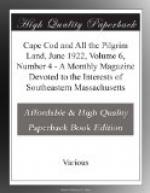The rows are set 4-1/2 to 5 feet apart, plants 14 to 15 inches in the row. The matted row system is used, but instead of allowing runners to set at will, each one is placed. The beds are raised six inches, rows when fully set are from 3-1/2 to 4 feet wide. Pine needles are used for a mulch mainly because they were handy at first, clean of weeds and easy to apply, but the pine needle is getting more and more obsolete, like the tallow candle, and unless the grower changes his method of mulching or else uses a motor truck and goes a long distance he is out of luck in the future.
The industry has seen hard times and about six years ago it was doubtful if it could survive. Growers were working as individuals and selling their berries and buying their fertilizer, crates and baskets. It was not uncommon for one grower to ship his season’s crop to as many as seven or eight different commission houses. This all led to confusion. The commission man could not depend on a steady and sure supply. By splitting up a crop in this way the grower actually competed with himself. Finally, by necessity, he was forced to combine with his neighbor and pool a common interest. The growers were guided into a co-operative association, to a large degree, by the assistance of Mr. Wilfrid Wheeler, then Secretary of the State Board of Agriculture.
Mr. George C. Lillie was employed as manager, and right from the start the association rallied and has been gaining ground ever since. At present this association, known as the Cape Cod Strawberry Growers’ Association, numbers ninety-eight men. They are incorporated, hold shares in the association, and sell their berries through one commission house instead of seven or eight.
There are two grades of berries sold, only one of which carries the association stamp. Each member has a number which is placed on his crate and about 80 per cent of the crop is shipped under the stamp of the association. The members are paid on Wednesdays and Saturdays during the shipping season. They also pool their fertilizer order of over 200 tons, as well as that for crates and baskets. Payment for these commodities are deducted from returns on the berries. Last season the association shipped about seventy carloads of berries. This is probably over two-thirds of the entire output for Falmouth. Each car holds about 170 80-quart crates, and practically half are shipped in iced cars. The berries leave Falmouth at 9 p.m. and arrive in Boston at 6 a.m. They are there distributed to various points, some going, we understand, as far north as Bangor, Maine.
The varieties grown are Echo, Howard 17, Abington and King Edward. The first named are more common, but indications point to a rapid change to the Howard 17. The Echo berry has proved a splendid variety for this section, as it stands up so well under shipment. The Howard 17 is nearly as good a shipper, but considered a better quality berry and does nicely on our Cape soils. The picking season is from three to four weeks. Pickers are usually paid 2 cents a quart, and a good picker will make from $3 to $4 a day. Five thousand quarts is considered a fair yield per acre for the section.




